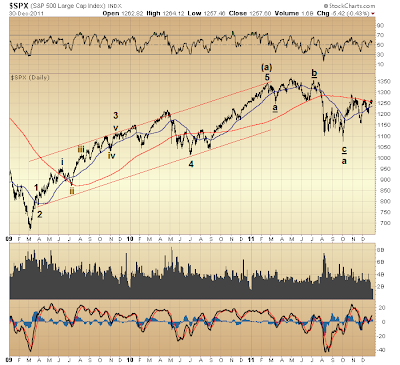A few years back, amidst a different, index-driven Elliott wave-based view forward, the wave count indicated above was thought a good possibility. At the time IBM had corrected approximately 61.8% of its 2008-2009 loss and appeared well-poised for the grande finale of its corrective wave forming since its 1999 top. However, July 2009's broadly influential, massive short squeeze served to put IBM on a different course in forming this corrective wave. Rather than having already completed wave B, turns out this wave still was in the midst of forming...
Unfolding off IBM's 2002 bottom is but a larger, 5-3-5 "zig-zag" than that previous thought, which nevertheless still is alternating from the 3-3-5 "flat" forming off IBM's 1999 peak completing in 2002. Whether wave (c) of B reached its peak in March of this year remains to be seen, but making this a good possibility is the fact that, IBM was not one of the NYSE-listed issues counted among the sudden, out-of-the-blue explosion of issues reaching new 52-week highs earlier this month. A sea of central bank provided liquidity notwithstanding, apparently there's only so much fake to go around. Judging by volume here, too, "fake" is no exaggerated summary of the impetus behind IBM's surge these past few years.
Given yesterday's Elliott wave-based proposition suggesting the 4th and 5th waves of a "rising wedge" forming wave (c) of B in major indexes still are slated to unfold over weeks ahead, IBM, rather than in kind continuing its advance, could be among issues showing first signs of weakness.
This possibility leads to wondering about prospect for a more broad-based, first sign of weakness that could (more likely "should") be displayed vis-a-vis the NYSE's cumulative advance-decline line coinciding with completion of wave (c) of B. Long established is the fact that, were the NYSE Composite Index tracking its cumulative advance-decline line, its print probably would be close to double today's. That the Composite Index lags so badly is but more testament to an entirely "fake" impetus behind the market's advance since March '09 bottom. Prospect that a "rising wedge" is unfolding to form wave (c) of B, then, would be more effectively confirmed should the NYSE cumulative advance-decline line, on its own account, begin to present a broad-based first sign of weakness during formation of the rising wedge's 4th and 5th waves.
IBM being among post-March '09 bottom leaders with a good chance of diverging from the broad market from this point forward, there are other "issues," more aptly called "garbage," whose performance since March '09 defies "fake" because what's dragging it down is destined to become the little engine that could, instead of the "headwind"—the heavy caboose—it contrarily seems more widely perceived today...
The pain in Spain will be IBM's bane. And by no means will this stock alone be suffering the euro Ponzi scheme's collapse. For all intents and purposes every stock will suffer in ways too few today dare imagine.
(Duly note the "holding on for dear life" phenomena displayed during $EWP's lift off its March '09 bottom via the volume of shares exchanged over the interim of its subsequent advance. We'll be seeing a similar, failed consequence more broadly once major U.S. indexes peak sometime over the weeks and months ahead.)

* * * * *
© The Risk Averse Alert — Advocating a patient, disciplined approach to stock market investing. Overriding objective is limiting financial risk. Minimizing investment capital loss is a priority.Analysis centers on the stock market's path of least resistance. Long-term, this drives a simple strategy for safely investing a 401(k) for maximum profit. Intermediate-term, investing with stock index tracking-ETFs (both their long and short varieties) is advanced. Short-term, stock index options occasionally offer extraordinary profit opportunities when the stock market is moving along its projected path.
Nothing is set in stone. Nor is the stock market's path of least resistance always known. More often than not, there are no stock index option positions recommended.
 There's an easy way to boost your investment discipline...
There's an easy way to boost your investment discipline...Get Real-Time Trade Notification!






































